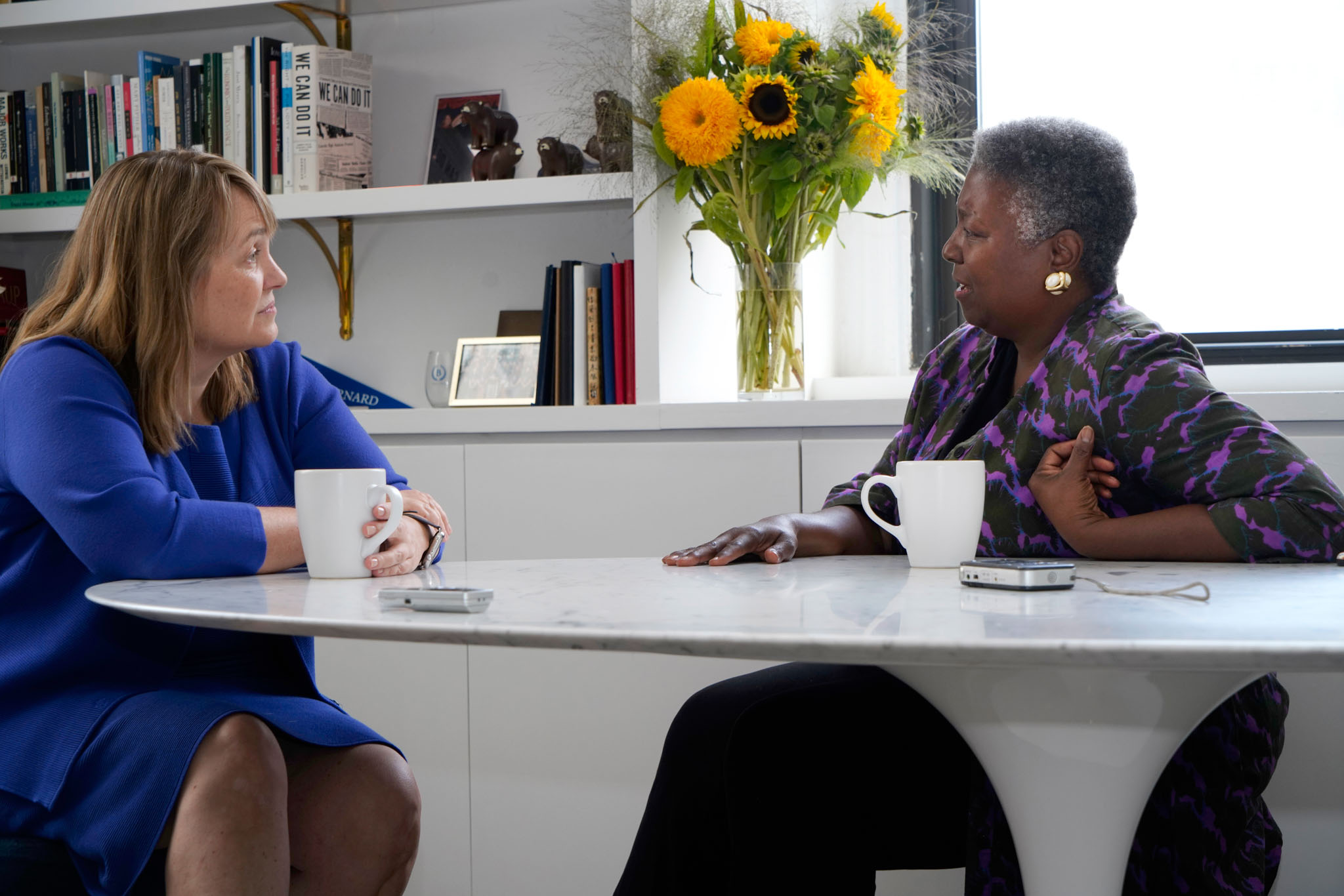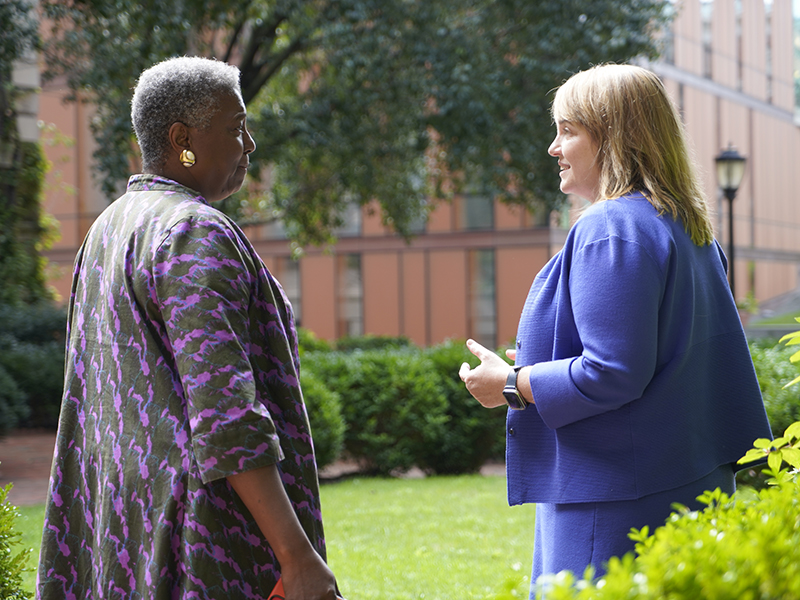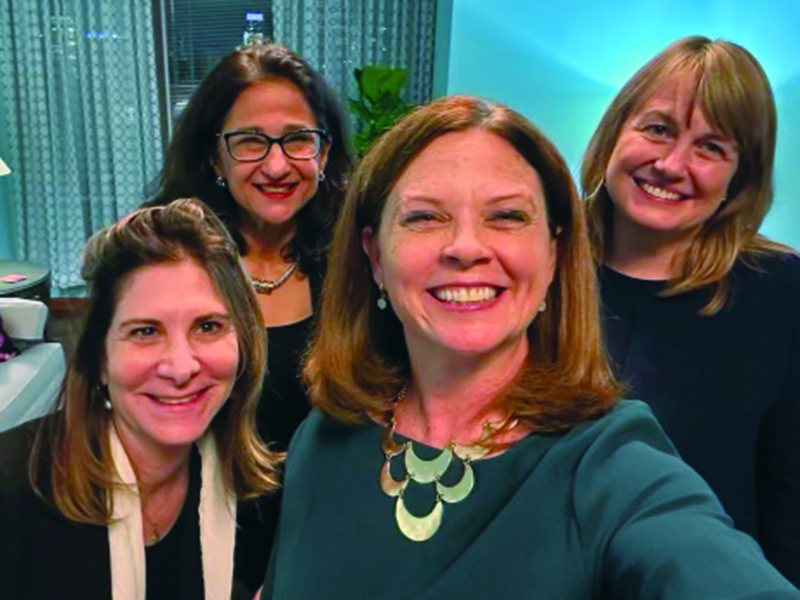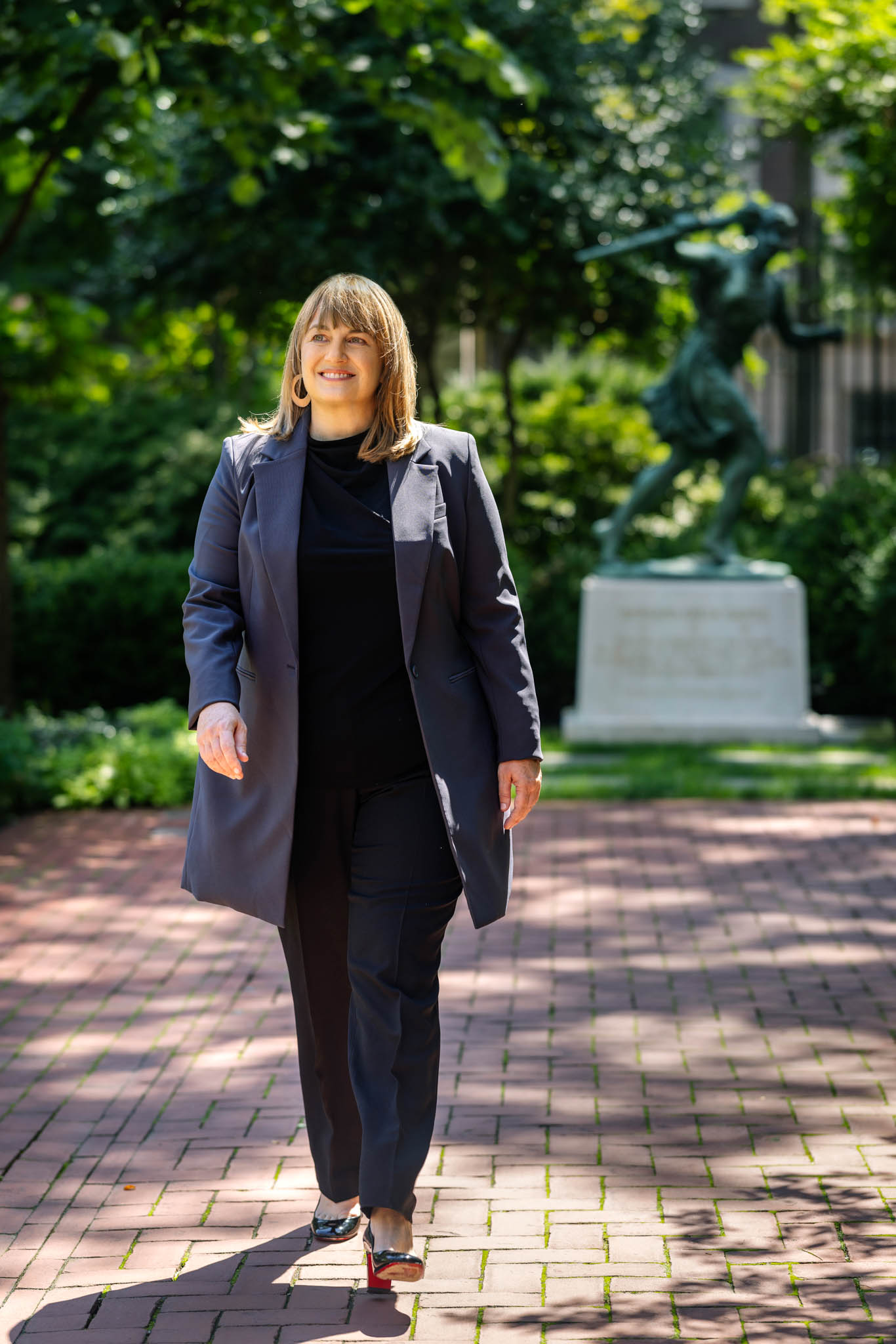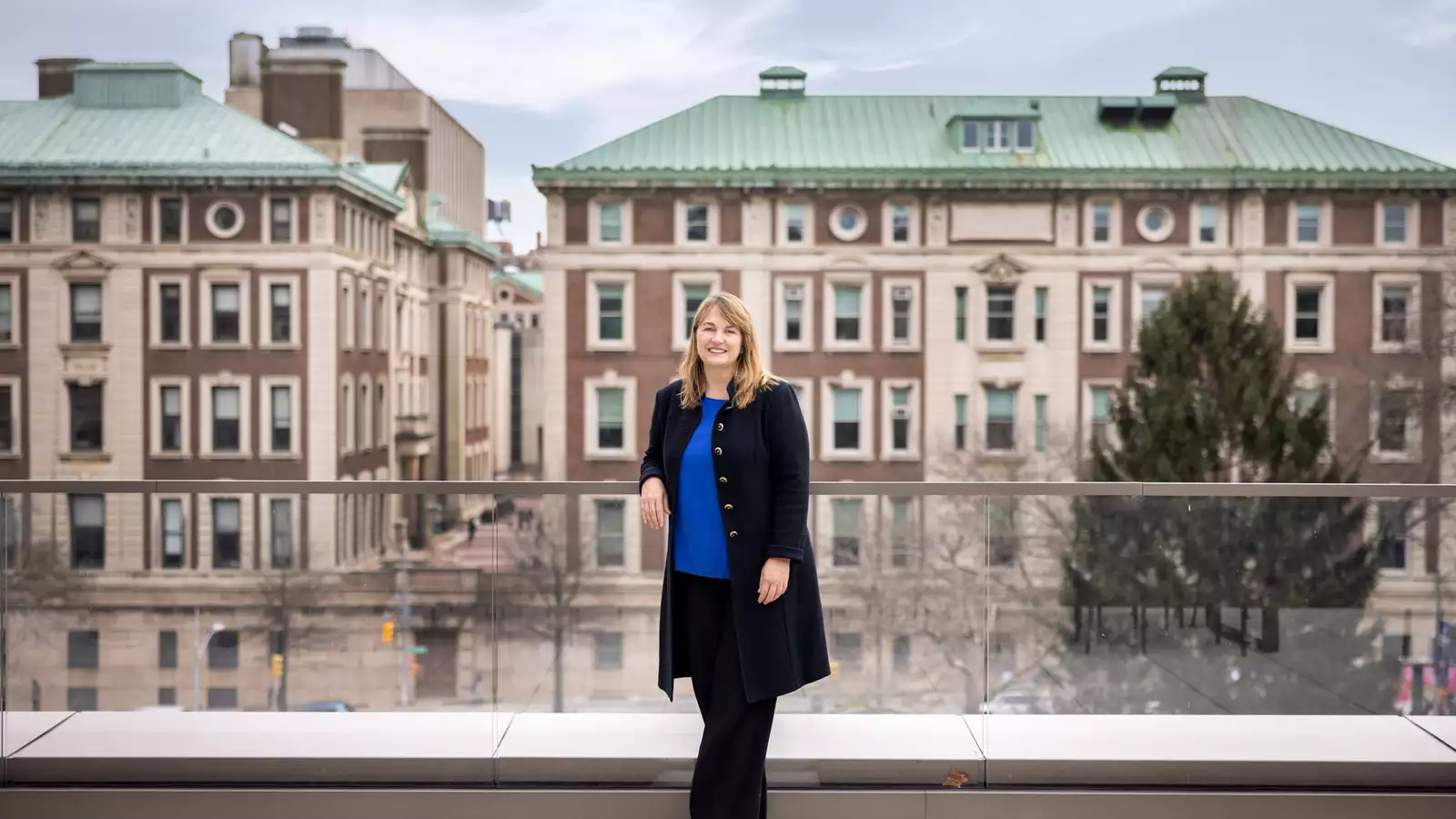
In June, Laura Rosenbury began her tenure as Barnard College’s ninth president. A leading feminist legal theorist, Rosenbury started her career as a litigation associate at the global law firm Davis Polk & Wardwell in New York City and went on to clerk for federal judges. From 2015 to 2023, Rosenbury served as the Dean and the Levin, Mabie & Levin Professor of Law at the University of Florida Levin College of Law. She was the first woman to hold this role. At the start of the fall semester, President Rosenbury sat down with Barnard trustee Marcia Sells ’81, P’23, who is the Metropolitan Opera’s chief diversity officer and the former dean of students at Harvard Law School, to talk about the value of engaging with different viewpoints, the lessons gained from law school, and being among a new cohort of women leading New York City’s higher-ed institutions.
Marcia Sells: So how was your first Move-in Day with students as the president of Barnard?
Laura Rosenbury: The energy was contagious. You walked through the gates, and there was the DJ and cheering. It was such a really warm welcome.
And how are you feeling as you move into this role from dean of a law school to president of the College? I still have so much to learn about Barnard — it is such a dynamic place.
It’s been wonderful getting to meet people, learn more about the history of the College, and listen to the community’s hopes and dreams for what’s next. It’s all about building upon strengths — making sure we preserve the special culture of Barnard while pushing ourselves to do even more.
There’s so much to learn! It will take time, but what steps are you taking to get to know the Barnard community?
When I arrived on campus, I knew the best way to really build an understanding of the needs, interests, and goals of our community is to go on a listening tour and to speak to different members and stakeholders at the College. Since the summer, I’ve been trying to meet with every faculty member one on one. It’s a slow process, but hopefully by the end of the semester, I will have talked with most of our wonderful faculty. Starting in the fall, I will be holding community conversation sessions with students, parents, and alumnae.
That’s wonderful. It will be a busy semester for you.
It will, yes, but I am so looking forward to these conversations, because they will be key to informing our priorities for the College and creating a road map for the future.
As you look at this moment in time for Barnard, and education in general, what are some of the things that you’re thinking about and hoping for?
I mean, not all in the first year, of course! I think something that is facing the entire nation, but certainly at colleges and universities, is a fear of engaging with multiple sides of an issue. I think Barnard could lead as an example of how we could better connect across difference and have dialogue across difference. When I talked to the parents on Move-in Day, I said one of my goals is to challenge the students, which means that we don’t want Barnard to be an echo chamber — to just promote one point of view. It’s important that we are very upfront from the beginning that students are going to encounter people with different backgrounds, perspectives, and ideologies. There shouldn’t be pressure to assimilate to one dominant viewpoint but instead to learn from one another. I believe deeply in that, and many of our professors do as well.
Also, the nature of the academic enterprise that you and I participated in while at law school — you at Harvard and I at Columbia — requires that [dialogue] even when it’s hard. It’s not just advocating for a particular point of view but really understanding and deepening that knowledge base, even when it’s challenging. That was always the difficult part — the humanity — recognizing there was a person on the other side of an issue and being empathetic.
Empathy is so important. And this is where our mutual friend, our eminent former colleague and mentor Martha Minow, comes in. She was my civil procedure professor. On the first day of my first semester, she told us that this class is about one question: “Can words constrain power?” It was a different way of thinking about law but one that really appealed to me. If we’re going to really grapple with this question, we have to be able to put ourselves in other people’s shoes. And that is the human side — having that empathy is so critical to representing one side or another, while following consistent procedures. Right now, throughout our society, there’s a tendency to vilify people who have different points of view instead of being curious about them — instead of saying, ‘How did they come to have that point of view?’ or ‘What was their journey?’ Because we have students coming from all over the world, there is a real opportunity to engage with different ideas but also meet people who are radically different from you.
Can you tell me how engaging with different perspectives might have informed your own?
Well, at my welcome to new students, I talked to them about Nalini P. Kotamraju, my first-year roommate, from Chicago. She was born in Curaçao, a former Dutch colony in the Caribbean, to a mother whose ancestors were brought over as slaves. Her father was originally from Hyderabad, India. Her first language was Papiamentu, which is the indigenous language there. [When she was] age 5, her dad got a job in Chicago and the family moved there. Unlike me, she went to the same school from kindergarten to high school, whereas I attended six different schools. She was from a city, whereas I grew up on my grandparents’ corn and soybean farm in Indiana. We were different in so many ways, and yet she’s my closest friend. She is my family — my chosen family.
I love that idea of a “chosen family.” Did you find that during your own college experience?
Yes, very much so. When I graduated from law school, several of my closest friends showed up. Nalini flew in from San Francisco, a college friend in Boston joined, and one came from New York. And then Martha took us all out!
That’s so Martha. If you find those people during your journey at college, they will be your chosen family. One of the things the pandemic made us realize is that a big part of the educational process is getting to know both yourself and other people, not only in the classroom but also in the greater context of school. It’s a very different experience to be virtual all the time, as opposed to being able to read someone’s emotions when you’re face to face.
Yes, it is. Because we were in Florida, we were teaching in person, even in the fall of 2020. But then it was pre-vaccine, so we also had mask mandates. This meant that in the classrooms, our facial expressions were hidden, and so I quickly learned how to read eyes, because so much of my approach to teaching is drawing students out, to try to look for the people who are silent yet engaged and encourage them to participate.
The reintegration into in-person has been part of the challenge, and [this distance] also sadly exacerbated what you were talking about in terms of the challenges we have of recognizing other people’s humanities. Now we have this opportunity to really engage and, at the same time, challenge ideas — and become comfortable doing so, because now we can see each other. There’s no mask hiding us.
And to be intentional about it. Yesterday I was talking to Carl Wennerlind, the chair of the History Department, who is also a scholar of capitalism, and I asked him how comfortable he feels drawing out students to explore multiple positions. It’s interesting because he does what I think many law school professors do — he has structural techniques. At one point during his class, he adopts a pro-capitalism perspective and asks all the students to focus on the strength of the pro-capitalist arguments. Then the next day, they have to do the exact opposite, and they take a skeptical or critical perspective on capitalism. And he said that, over time, it becomes less binary — you’ll see some of the overlap but also have a better sense of the strengths and weaknesses of both sides. He explained that if you’re going to be committed to tackling capitalism throughout your career, you need to know its strengths in order to better frame your arguments. So by forcing students to engage with both sides, hopefully it better prepares them.
You have to engage with the work and the readings. And then you start to ask those big questions, but you can’t do it if you ignore them.
Right? And to not immediately go to critique but instead say, “What is the author trying to do here? What are the strengths of this article?” When I talked to the parents about not wanting Barnard to be an echo chamber, many of them came up afterwards and asked how we plan to do this with the country so divided. And I said we have to try. It might be an audacious statement, but we are going to try [to have dialogue across difference]. We can’t give up just because it’s hard. Maybe we’ll even be able — given our smaller community and the passions of our students — to eventually lead in this area. It will be another way that Barnard can be distinctive.
Well, “audacious” fits Barnard. I do want to ask you — what are the things that you’re looking forward to doing in New York City for fun? I asked members of the senior leadership team to share their favorite nontouristy things to do, and almost every suggestion was something I had never done, from taking a water taxi to visiting the Cloisters. I would also like to come to the opera.
One of the things I say a lot about art is that it can raise big questions, and like we were talking about, it can engage people, so please, we’ll have to make sure that you can attend the opera. Where Barnard is located offers the opportunity to see a lot of great things, such as the Apollo [Theater] and the Schomburg Center for Research in Black Culture.
It’s wonderful. Barnard is very much part of the city. One of my goals is to think about how we can better connect to our local communities in Harlem and Morningside Heights but also how we can be a better partner with the mayor’s office and with other higher-ed institutions.
Speaking of higher ed, you’re in good company. A number of institutions in the city are now being led by women.
I actually had dinner with three firsts last night: Tania Tetlow, the [first woman] president of Fordham; Minouche Shafik, the first woman president of Columbia; and Linda G. Mills, the first female president of NYU. It was very powerful. A lot of the discussion was about being the first, and having been the first female dean at the University of Florida Levin College of Law, I know what a big deal it is. But I have to say I was also really thankful that there’s such a long tradition of female leadership at Barnard. And it’s not female leadership — it’s just leadership, period.
